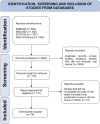Exploring beyond Common Cell Death Pathways in Oral Cancer: A Systematic Review
- PMID: 38392321
- PMCID: PMC10886582
- DOI: 10.3390/biology13020103
Exploring beyond Common Cell Death Pathways in Oral Cancer: A Systematic Review
Abstract
Oral squamous cell carcinoma (OSCC) is the most common and lethal type of head and neck cancer in the world. Variable response and acquisition of resistance to traditional therapies show that it is essential to develop novel strategies that can provide better outcomes for the patient. Understanding of cellular and molecular mechanisms of cell death control has increased rapidly in recent years. Activation of cell death pathways, such as the emerging forms of non-apoptotic programmed cell death, including ferroptosis, pyroptosis, necroptosis, NETosis, parthanatos, mitoptosis and paraptosis, may represent clinically relevant novel therapeutic opportunities. This systematic review summarizes the recently described forms of cell death in OSCC, highlighting their potential for informing diagnosis, prognosis and treatment. Original studies that explored any of the selected cell deaths in OSCC were included. Electronic search, study selection, data collection and risk of bias assessment tools were realized. The literature search was carried out in four databases, and the extracted data from 79 articles were categorized and grouped by type of cell death. Ferroptosis, pyroptosis, and necroptosis represented the main forms of cell death in the selected studies, with links to cancer immunity and inflammatory responses, progression and prognosis of OSCC. Harnessing the potential of these pathways may be useful in patient-specific prognosis and individualized therapy. We provide perspectives on how these different cell death types can be integrated to develop decision tools for diagnosis, prognosis, and treatment of OSCC.
Keywords: emerging types of cell death; ferroptosis; necroptosis; oral cancer; pyroptosis; systematic review; tumor microenvironment.
Conflict of interest statement
The authors declare no conflicts of interest.
Figures




References
-
- Galluzzi L., Vitale I., Aaronson S.A., Abrams J.M., Adam D., Agostinis P., Alnemri E.S., Altucci L., Amelio I., Andrews D.W., et al. Molecular mechanisms of cell death: Recommendations of the Nomenclature Committee on Cell Death 2018. Cell Death Differ. 2018;25:486–541. doi: 10.1038/s41418-017-0012-4. - DOI - PMC - PubMed
-
- Yan G., Elbadawi M., Efferth T. Multiple cell death modalities and their key features (Review) World Acad. Sci. J. 2020;2:39–48. doi: 10.3892/wasj.2020.40. - DOI
Publication types
LinkOut - more resources
Full Text Sources

